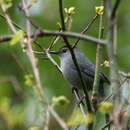More info for the terms:
density,
shrubGray catbirds were rated as tolerant of habitat alteration; they do not
require a specific habitat and are able to make use of
less-highly-preferred habitat, albeit at lower densities [
21].
In Pennsylvania, gray catbirds were present in clearcut stands of aspens
and oak-pine. They were observed to use the edges of stands more often
than interiors (defined as more than 83 feet [25 m] from the interface),
and preferred older stands [
30]. Nongame bird densities were censused
in bigtooth aspen (Populus grandidentata)-quaking aspen-pitch pine
(Pinus rigida), and in bear oak (Quercus ilicifolia)-dwarf chinkapin oak
(Q. prinoides)/blueberry stands that were uncut, 50 percent clearcut,
or 75 percent clearcut. Length of time since treatment was 2, 6, or 12
years. Gray catbirds were encountered more often than expected in 75
percent clearcut aspen stands and were not encountered in uncut stands
of either aspens or oaks. Within the 50 percent clearcut stands, gray
catbirds were more common in 12-year-old stands of both aspens and
oak-pine than in 2-year-old stands [
32].
Stauffer and Best [
21] made the following predictions about the effect of
habitat alteration on gray catbird density:
1) conversion of woody vegetation to hayfield or pasture will eliminate
gray catbird
2) reduction of woody vegetation to narrow strips along streams will
reduce gray catbird density
3) partial removal of the canopy will increase gray catbird density
4) thinning of shrub and sapling layers will reduce gray catbird density.
The authors were unable to make a prediction for the effect of partial canopy
removal with shrub thinning, since the separate treatments have opposite
effects [
21].
Tall structures create a hazard to migrating gray catbirds because most
migration occurs at night [
25]. Structures listed as hazards include
lighthouses and the Washington Monument [
2].
Nest Parasitism: Gray catbirds are infrequent hosts to brown-headed
cowbirds. Gray catbirds will eject eggs of other species that are found
in the nest [
25]. However, if a naive gray catbird is exposed to a
brown-headed cowbird egg before her own eggs are laid, she will "learn"
the cowbird egg, eject her own eggs, and rear the cowbird chick [
38].

